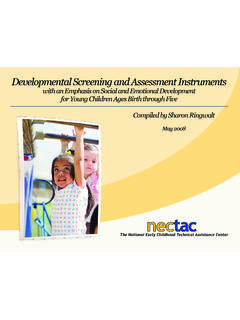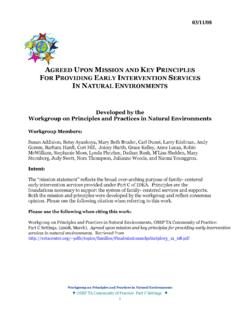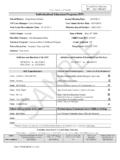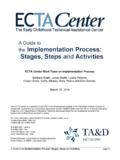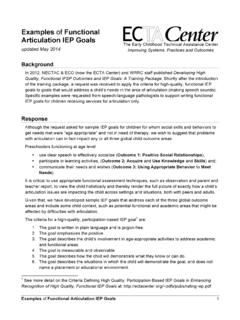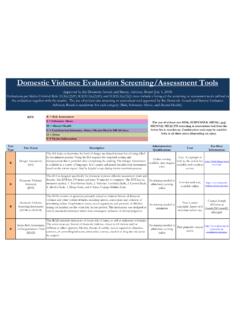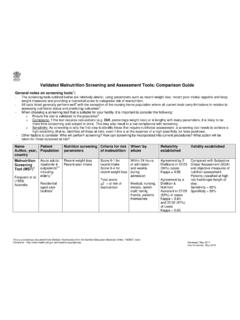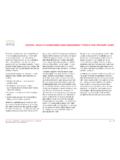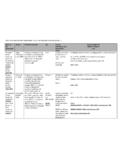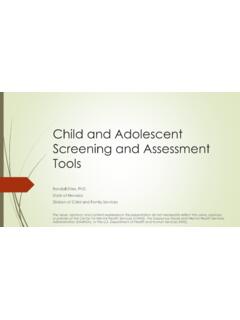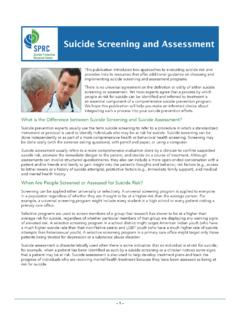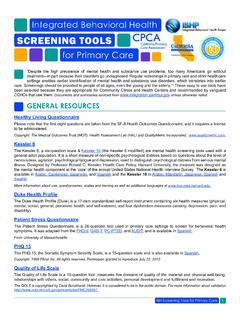Transcription of Screening and Assessment instruments May 2008 TO PDF
1 developmental Screening and Assessment Instrumentswith an Emphasis on Social and Emotional Developmentfor Young Children Ages Birth through FiveCompiled by Sharon RingwaltMay 2008 The National Early ChildhoodTechnicalAssistance Center In recent years, there has been a growing emphasis on the mental health and social and behavioral developmental needs of very young children. In response, state administrators and local providers of early intervention and preschool programs have worked to strengthen their Screening and Assessment of children s social and emotional development. They have sought guidance from technical assistance providers, including the National Early Childhood Technical Assistance Center (NECTAC) about appropriate tools to use. To meet this need, NECTAC, as part of its cooperative agreement with the Office of Special Education Programs, compiled this product. This list of instruments was gathered through a review of: the infant mental health literature, states Part C and Part B Section 619 Web sites, Screening and Assessment texts, and publishers Web sites.
2 The complete list of sources used is at the end of this compilation. The Screening instruments include both those that address multiple developmental domains as well as those that focus on the social-emotional developmental domain. The Screening instruments are further sub-divided into those which must be administered by professionals and those that may be completed by family members or other caregivers. A list of Assessment instruments that must be administered by professionals is also provided. The information for each instrument includes a description, the age range for which the instrument was validated, the time to administer, the scoring procedure, psychometric properties, and requirements for administrators, and a link to, or address for, the publisher or source of more information. Suggested citation: Ringwalt, S. (2008). developmental Screening and Assessment instruments with an emphasis on social and emotional development for young children ages birth through five.
3 Chapel Hill: The University of North Carolina, FPG Child Development Institute, National Early Childhood Technical Assistance Center. This document appears at: ~pdfs/ This resource is produced and distributed by National Early Childhood Technical Assistance Center (NECTAC), pursuant to cooperative agreement H326H060005 with the Office of Special Education Programs, Department of Education (ED). Grantees undertaking projects under government sponsorship are encouraged to express their judgment in professional and technical matters. Opinions expressed do not necessarily represent the Department of Education s position or policy. A list of currently available NECTAC publications can be viewed at our site on the World Wide Web or requested from us. NECTAC is committed to making the information it disseminates fully accessible to all individuals. To acquire this publication in an alternate format, please contact us through our Web site or email address below.
4 NECTAC is a program of the FPG Child Development Institute at The University of North Carolina at Chapel Hill. Campus Box 8040, UNC-CH Chapel Hill, NC 27599-8040 919-962-2001 phone 919-966-7463 fax Project Director: Lynne Kahn Project Officer at OSEP: Julia Martin Ringwalt, S. - developmental Screening and Assessment May 2008 2 ~pdfs/ Ringwalt, S. - developmental Screening and Assessment May 2008 3 ~pdfs/ Screening AND Assessment instruments I. MULTI-DOMAIN Screening instruments THAT MAY BE COMPLETED BY FAMILIES OR OTHER 4 Ages and Stages Questionnaire (ASQ), 2nd 4 Child Development Inventories (CDI) .. 4 Kent Inventory of developmental Skills 3rd Edition (KIDS) .. 5 The Ounce Scale .. 5 Parents Evaluations of developmental Status (PEDS) .. 5 Pediatric Symptom Checklist .. 6 II. MULTI-DOMAIN Screening instruments TO BE COMPLETED BY 7 Battelle developmental Inventory Screening Test (BDIST) .. 7 Bayley Infant Neurodevelopmental Screener (BINS).
5 7 Birth to Three Assessment and Intervention, 2nd Edition (BTAIS-2), Screening Test of developmental Abilities .. 7 Brigance Screens .. 8 Denver developmental Screening Test II (DDST-II) .. 8 developmental Indicators for the Assessment of Learning-Third Edition (DIAL-3) .. 9 developmental Profile 3 (DP-3) .. 9 Early Childhood Inventory-4 (ECI-4) .. 9 Early Screening Inventory Revised (ESI-R) .. 10 ESP: Early Screening 10 Infant-Toddler and Family Instrument (ITFI) .. 11 Infant-Toddler developmental 11 III. SOCIAL-EMOTIONAL Screening instruments THAT MAY BE COMPLETED BY FAMILIES OR OTHER 12 Ages and Stages Questionnaires: Social-Emotional (ASQ:SE) .. 12 Behavioral Assessment of Baby s Emotional and Social Style (BABES) .. 12 Brief Infant/Toddler Social Emotional Assessment (BITSEA) .. 12 Carey Temperament 13 Devereaux Early Childhood Assessment Program (DECA) .. 13 Early Screening 14 Eyberg Child Behavior Inventory (ECBI).
6 14 Greenspan Social-Emotional Growth 14 Infant/Toddler Symptom 14 Mental Health Screening Tool (MHST) .. 15 Pediatric Symptom Checklist (PSC).. 15 Preschool and Kindergarten Behavior Scales 2nd Edition (PBKS-2) .. 15 Social Skills Rating 15 Strengths and Difficulties Questionnaire (SDQ) .. 16 Temperament and Atypical Behavior Scale (TABS Screener) .. 16 IV. SOCIAL-EMOTIONAL Assessment instruments TO BE COMPLETED BY 17 Achenbach System of Empirically Based Assessment Preschool Module (ASEBA) .. 17 Behavior Assessment System for Children, 2nd Edition (BASC-II) .. 17 Early Coping 18 Functional Emotional Assessment 18 Vineland Social-Emotional Early Childhood Scales (Vineland SEEC) .. 18 V. SOURCES USED IN THIS 19 Ringwalt, S. - developmental Screening and Assessment May 2008 4 ~pdfs/ I. MULTI-DOMAIN Screening instruments THAT MAY BE COMPLETED BY FAMILIES OR OTHER CAREGIVERS Name of Instrument Description Age Range Time Frame Scoring Psychometric Information May be administered by Ages and Stages Questionnaire (ASQ) - 2nd Ed.
7 The Ages & Stages Questionnaire (ASQ) system is designed to be implemented in a range of settings & can easily be tailored to fit the needs of many families. Clear drawings & simple directions help parents indicate children s skills in language, personal-social, fine & gross motor, & problem solving. The ASQ involves separate copy-able forms of 30 items for each age range (tied to well-child visit schedule). The measure can be used in mass mail-outs for child-find programs as a first-level Screening tool to determine which children need further evaluation to determine their eligibility for early intervention or preschool services. The questionnaire can also be used to monitor the development of children at risk for disabilities or delays. Published in English, Spanish, French & Korean, other translations are in development. A video is available that demonstrates completion of the questionnaire for two children. Their family is introduced & guided through questionnaire completion by a home visitor.
8 Viewers discover how to explain the ASQ Screening process, redefine items to reflect a family's values & culture, create opportunities for child learning & development, & promote positive parent-child interaction. Birth to 60 months ~ 15 - 20 minutes, less if parents complete independently (each questionnaire takes 10-20 minutes to complete, with 2-3 minutes to score) A 2 SD below the mean cut-off score is used for questionnaires at 4, 8, 12, 16, 24, 30 & 36 months A 75 developmental quotient is the cut-off for questionnaires at 6, 10, 14, 18, 22, 27 & 33 months. Scores provide guidance on which children to refer for diagnostic testing, which to provide with skill-building activities & recommend to re-screen, & which children simply to provide activities for. The normative sample consisted of educationally, economically, and ethnically diverse families (Caucasian, African American, Hispanic, and Native American), but the sample was not nationally representative.
9 Test-retest reliability, inter-rater reliability, and internal consistency: acceptably high to strong results. Internal consistency and predictive validity: moderate results. Under-referral rates ranged from 1% to 13% across the age intervals; over-referral rate ranged from 7% to 16%. Sensitivity range from 38% to 90% across the intervals, while specificity ranged from 81% to 90%. Concerns: The normative sample was not nationally representative parents from Asian backgrounds appear underrepresented. Product information: Parents; home visitors; other providers; requires a 6th grade reading level. Professionals score the questionnaires. Child Development Inventories (CDI) Three separate instruments [the Infant Development Inventory (IDI), Early Child Development Inventory (ECDI), & the Preschool Development Inventory (PDI)] each with 60 yes-no descriptions. Inventories measure a child s development in five domains: gross motor, fine motor, language, comprehension, and person-social.
10 Items tap the better predictors of developmental status only. A 300-item Assessment -level version may be useful in follow-up studies or sub-specialty clinics & produces age equivalent & cutoff scores in each domain. 3 - 72 months; IDI for 3-18 months; ECDI for 18-36 months; PDI for 36-60 months ~ 10 minutes, less if parents complete independently The ECDI & the PDI produce a single cutoff tied to standard deviations. T-scores may be calculated from this information. The IDI provides cutoffs for each of five developmental domains & illustrates both significantly advanced & delayed development. The normative sample reported in 1995 consisted of 1,322 children; it was three times larger than the original MCDI sample for the same ages (1-4 yrs), and represented a broader range of demographics. A February 2006 article in the Journal of Clinical Psychology reports that a review of 132 cases utilizing parental report on the CDI found these data to be highly correlated (r = ) with mental ages obtained during formal psychometric evaluation.
